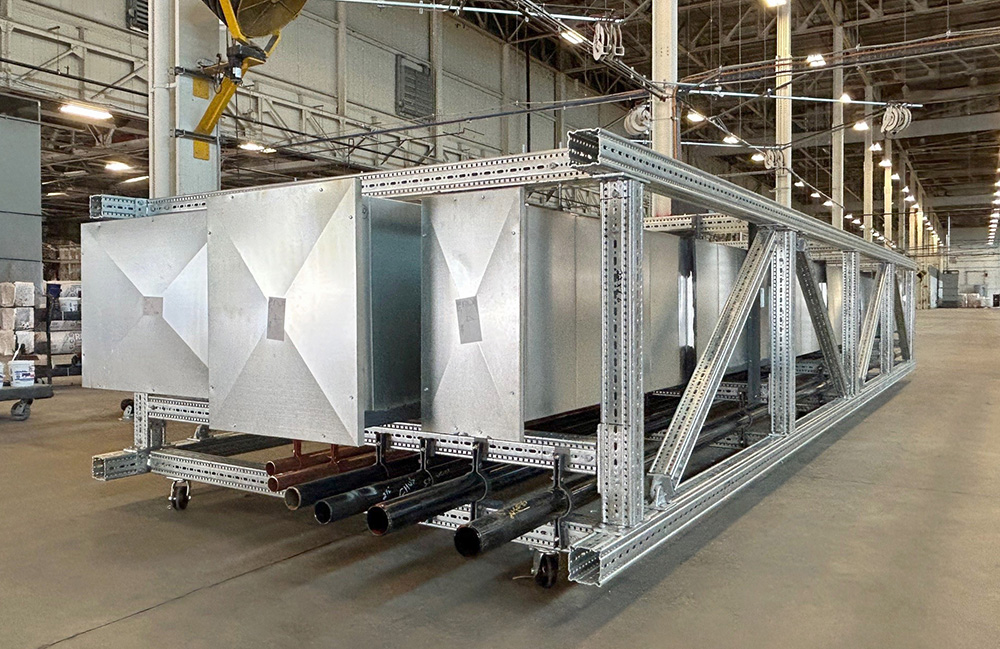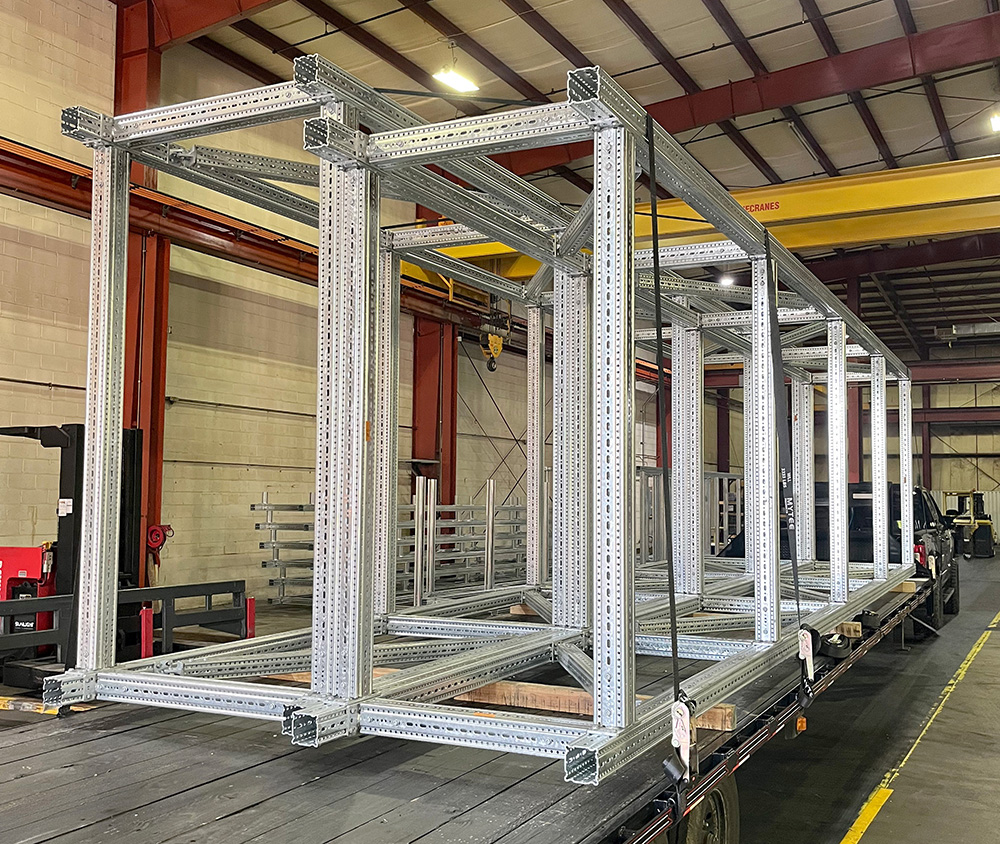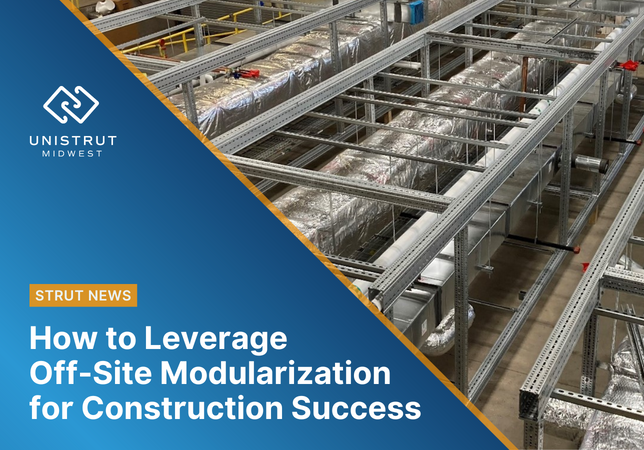How to Leverage Off-Site Modularization for Construction Success
September 17, 2024
As construction projects grow in scope and demand, our team has found that off-site modularization (including prefabrication) is becoming an increasingly attractive option for contractors. With years of prefabrication experience under our belts, we've seen firsthand how this solution can benefit a wide range of projects. While there are plenty of pros to this approach, there are some cons as well. Here are a few things to consider before moving forward with off-site modularization for your next construction project.
Pros of Off-Site Modularization

Reduce On-Site Man Hours and Improve Safety
The basis of off-site modularization is that anything that can be done ahead of time – whether that's cutting channel to size, pre-assembling fittings, or building entire systems – is completed off site and delivered to the work site once it is ready for installation. Since much of the system is already pre-assembled, this greatly streamlines the installation process, minimizing the amount of required on-site man hours. With the current shortage of skilled labor in the industry, anything that gives time back to your skilled tradespeople is a big win.
While assembling your system off site cuts down on on-site labor, it also increases safety conditions for your team. With so much assembly work completed ahead of time in a controlled warehouse setting at ground level, the amount of time required for your installation team to work at height is slashed. Less time in risky work conditions, such as overhead stick installations, leads to improved safety for your team.
Faster Speed to Market
Ultimately, off-site modularization shines for its ability to increase your speed to market. By building systems off site and then delivering a completed or nearly completed solution, your primary construction can occur in parallel with secondary system construction. Instead of waiting for your primary structure to be completed before starting on support systems, those secondary systems can be completed off site and ready to install as soon as your structure is buttoned up. From there, installation often occurs in a matter of hours, keeping your project on track.
This is an invaluable benefit for any construction project, but especially mission critical systems like data centers, where delays in completion can cost hundreds of thousands of dollars in downtime each week that the project is behind schedule.
We've seen this benefit firsthand with our clients, including a battery plant project where the schedule was continuously delayed, but the final due date remained unchanged. The client reached out to the Unistrut Midwest team for a solution that would help them make up their lost time without pushing back their deadline.
This client needed to run one million feet of pipe in a calendar year, a daunting task for traditional construction methods but a doable one with off-site modularization. Our team was able to design racks and pipe supports that allowed the client to install their pipe in 20-40 foot sections, speeding up installation. Additionally, by using our designs and recommended Sikla siFramo materials, the client was able to fabricate three to five racks per day instead of the traditional welded steel timeline of one rack every two days. By leveraging off-site modularization and working with our experienced team, this client was able to meet their deadline despite months of previous delays.
Cons of Off-Site Modularization

Lifting, Transportation, and Installation
The ultimate benefit of off-site modularization is that you receive a completed build to your site in the morning and it can be installed by the end of the day, as opposed to weeks or months of on-site building. This is only a benefit, however, if the proper coordination has been given to the logistical details.
A common complication for off-site modularization projects is when transportation, lifting, and installation details are finalized after the solution has been built. This can lead to oversights like a completed solution being too large to transport or fit through openings on site, inadequate lifting points for installation, or an installation plan that doesn't fit with existing structures on site. One of the biggest mistakes made in off-site modularization is treating these details as afterthoughts.
To avoid this, the Unistrut Midwest team includes the transportation and lift plan in the initial designs. Identifying where to lift and hang a structure so that it can be properly installed in the field allows our team to then build the structure accordingly, instead of retrofitting it for installation after it is completed.
On-Site Design Changes
Whether through human error, miscommunication, or incorrect measurements, it's possible for design plans to differ from actual field conditions in any build. When construction happens on site, those discrepancies can be dealt with as they come up, with designs changing on the fly as needed. With off-site modularization, those differences are only discovered when the completed build is delivered for installation and doesn't fit the installation site, seemingly sending the solution back to the drawing board.
There are two crucial ways to avoid this complication. First, work with a team experienced in off-site modularization (like Unistrut Midwest) that has contingency plans for such a complication. Second, build your solution with a material that makes on-site adjustments a breeze.
Working with modular systems like Unistrut or Sikla siFramo allows you to not only easily build solutions off site but also gives you the ability to make adjustments in the field. Both Unistrut and Sikla siFramo are non-welded systems, so any changes can be achieved with hand tools. Where something like out-of-level concrete would delay a welded steel installation by hours or days due to cutting and rewelding, required changes can be made on a Unistrut or Sikla siFramo system in a matter of minutes. Additionally, modular systems give you the flexibility to adjust your system in the future to accommodate growth or process changes.

